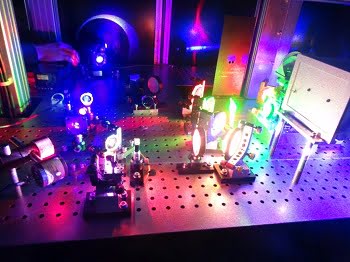“Our 15-year research project aimed to build a hologram printer with all the advantages of previous technologies while eliminating known drawbacks such as expensive lasers, slow printing speed, limited field of view and unsaturated colors,” said research team leader Yves Gentet from Ultimate Holography in France. “We accomplished this by creating the CHIMERA printer, which uses low-cost commercial lasers and high-speed printing to produce holograms with high-quality color that span a large dynamic range.”

The new printer uses low-power continuous-wave lasers to create holograms on a highly sensitive photomaterial developed by the researchers. Courtesy of Yves Gentet.
The researchers describe the printer in The Optical Society journal Applied Optics. The printer is able to create holograms with wide fields of view and full parallax on special photographic material designed by the researchers. Full parallax holograms reconstruct an object so that it is viewable in all directions, in this case with a field of view spanning 120°.
The holograms can be created from 3D computer generated models or from scans acquired with a dedicated scanner developed by the researchers. The holograms can also be used as masters to produce holographic copies.
In developing the printer, the researchers studied two previously developed holographic printer technologies to understand their advantages and disadvantages.
“The companies involved in developing the first two generations of printers eventually faced technical limitations and closed,” Gentet said. “Our small, self-funded group found that it was key to develop a highly sensitive photomaterial with a very fine grain rather than use a commercially available rigid material like previous systems.”
The CHIMERA printer uses red, green, and blue low-power, commercially available, continuous-wave lasers with shutters that adjust the exposure for each laser in a matter of milliseconds. The researchers also created an antivibrating mechanical system to keep the holographic plate from moving during the recording. Holograms are created by recording small holographic elements known as hogels one after another using three spatial light modulators and a custom-designed, full-color optical printing head that enables the 120° parallax. After printing, the holograms are developed in chemical baths and sealed for protection.
The hogel size can be toggled between 250 and 500 μm and the printing rate adjusted from 1 to 50 hertz (Hz). For example, if a hogel size of 250 μm is used, the maximum printing speed is 50 Hz. At this speed it would take 11 hours to print a hologram measuring 30 by 40 cm, about half the time it would take using previous systems based on pulsed lasers.
The researchers used the technology to create holograms that measured up to 60 by 80 cm showing various color objects including toys, a butterfly, and a museum object.
“The new system offers a much wider field of view, higher resolution, and noticeably better color rendition and dynamic range than previous systems,” Gentet said. “The full-color holographic material we developed provides improved brightness and clarity while the low-power continuous-wave lasers make the system easy to use.”
The researchers said that as the technology improves, especially 3D software, it may be possible to expand their hologram printing approach to medical or other advanced applications.
The research was published in Applied Optics (www.dx.doi.org/10.1364/AO.58.00G226).














 2
2